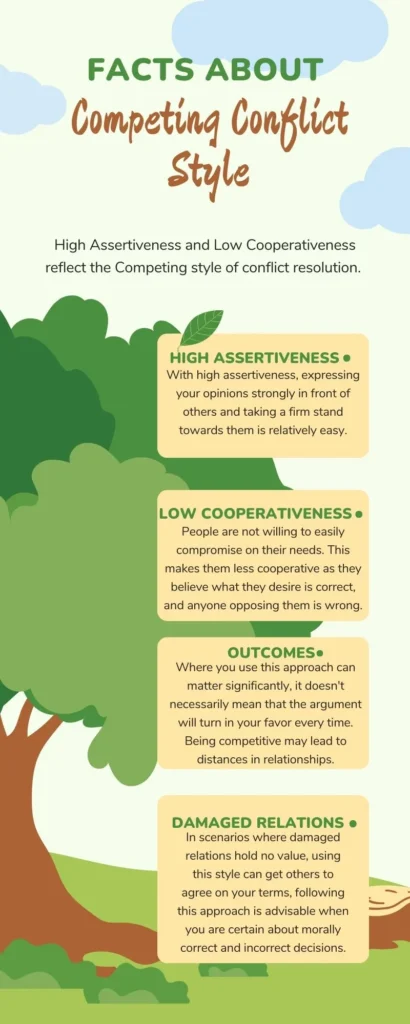Have you ever been in a situation where you had to be competitive and assert your needs strongly that you were neither cooperative nor wanted to compromise at all?
Have you ever dealt with people who give subtle importance to their opinions and concerns and the needs of others don’t matter to them during a conflict?
Was a resolution possible in any of the situations mentioned above?

High Assertiveness and Low Cooperativeness reflect the Competing style of conflict resolution. People adopting such a conflict resolution style can strongly express their opinions and views in front of others without any hesitation and remain firm on their points to the extent that the concerns of others don’t matter to them. They may use their authority and power to get their points across. We will delve in more detail to understand this conflict resolution style and discuss a few examples to explore the benefits and drawbacks of using this style.
Which Conflict Handling Style involves High Assertiveness and Low Cooperativeness?
If you have read my article on Thomas Kilmann’s two-dimensional model of conflict resolution, you must have gained some basic knowledge about the High Assertiveness and Low Cooperativeness Competing style of conflict resolution. However, today, we will delve into this topic in more detail to ensure we have a much better understanding of this conflict management style. Indeed, the choice of resolution style to adopt can vary from situation to situation but many people tend to be Competitive in the wrong circumstances which makes them regret their decisions later on.
With high assertiveness, expressing your opinions strongly in front of others and taking a firm stand towards them is relatively easy. People are not willing to easily compromise on their needs and desires and therefore, they prioritize self-concerns over the concerns of others. This makes them less cooperative as they are not ready to listen to others’ opinions because they believe what they desire is correct, and anyone opposing them is wrong. They can even exercise authority to bias the conflict resolution decision in their favor when necessary. Though it may seem somewhat selfish, sometimes it can help steer the conversation in the right direction which may lead to a conflict resolution.
Where you use this approach can matter significantly, if it’s a matter that challenges your self-esteem, then adopting competing behavior would make sense, however, it doesn’t necessarily mean that the argument will turn in your favor every time. For resolving household issues, using this conflict management style is not recommended at all as it may provide a short-term solution that may seem to align with your needs, but definitely may not result in a long-term resolution, there are high chances that the problem might resurface in a more significant way in the future.
It’s essential to understand that being competitive can lead to distances being created in relationships, and once these gaps start appearing it becomes difficult to heal such spaces even after many efforts. To maintain relationship harmony, it’s necessary to compromise to some extent, even if you believe you were entirely correct in that situation.
Whereas in scenarios where damaged relations hold no value, using this style can get others to agree on your terms. I suggest you should only follow this approach when you are certain about morally correct and incorrect decisions. Let’s understand this technique in more detail through an example.

What is an Example of High Assertiveness and Low Cooperativeness Competing Conflict Style?
- Stubborn or Adamant behavior: Often, you may have encountered people who are unwilling to listen to other’s concerns and are fixed on their stubbornness. For instance, in an argument where neither party is ready to listen to the other views and expects the resolution of the conflict to happen only when the other agrees to their terms and conditions, then in such circumstances, the probability of a peaceful and long-term resolution is low; even if a resolution is achieved, it’s unlikely to be peaceful or lasting.
- Fighting for your Rights: In a situation where someone is fighting for their freedom of speech, right to livelihood, self-respect, and self-esteem, etc. it is necessary to use the High Assertiveness and Low Cooperativeness competing style because it’s a fight for your rights, and there is no room for compromise. Using a competing behavior can be advantageous because expressing your thoughts and feelings is important; you need to ensure you are heard, and others agree with your terms.
- Demonstrate Authority and Power: Sometimes, when you have authority and power to influence others, High Assertiveness and Low Cooperativeness competing style can be quite advantageous in steering conflict resolution in your desired direction. In such cases, you can compel others to agree to your terms even if they are initially unwilling. However, it’s crucial to remember that with power comes responsibility, and misuse of authority can have detrimental consequences. Using the High Assertiveness and Low Cooperativeness competing conflict resolution style to uphold a morally correct decision is favorable, akin to our expectation from a judge in a court to deliver justice. Conversely, using power and authority to support an unjust cause can lead to repercussions such as loss of authority, self-respect, trust, etc.
- Arbitrary Behavior: Engaging in arbitrary behavior is another excellent example of high assertiveness and low cooperativeness, where an individual stubbornly sticks to their preferences, disregarding the concerns of others. Such individuals are usually less cooperative and typically only extend cooperation when it aligns with their motives. In such situations, conflict resolution tends to be one-sided, creating a win-lose scenario, and achieving a long-term and peaceful resolution becomes challenging.
- Selfish Behavior: Lastly, being selfish during a conflict can also be considered an example of demonstrating a High Assertiveness and Low Cooperativeness in competing conflict resolution style because by being selfish, one only thinks about their benefits, ignoring the concerns of others. In some situations, being selfish for personal gains may be deemed acceptable, but if you consistently prioritize your interests in every situation, others may start opposing you. This can lead to a loss of trust, rapport, and respect that you have earned in their eyes. In the context of relationships, being selfish can introduce bitterness, making it challenging to maintain a long-lasting and healthy connection.
Let us understand the High Assertiveness and Low Cooperativeness Competing conflict style through a case study:
Ayaan is the only son of his parents, and he lives with them in their ancestral home. Due to living in that same house since childhood, Ayaan has many memories attached to it that he doesn’t want to forget and that is the primary reason he doesn’t want to move and settle anywhere else. His parents belong to a middle-class family, and they dedicated their entire lives to providing their child with the best upbringing. They educated him well and fulfilled his desire to study in America, even though it wasn’t easily affordable for them.
Despite their financial constraints, they didn’t compromise on Ayaan’s upbringing and ensured he stood on his own feet. After retirement, Ayaan became the main support for his aging parents, taking responsibility for all household expenses and their care. He had a deep love for his parents and was determined not to leave any gaps in taking care of them.
Ayaan married his girlfriend Kiara whom he first met while studying at the University of Pennsylvania. Love blossomed between the two and their relationship eventually led to marriage. Both of them were from the same city, so they settled down there. However, Kiara had always been raised in a nuclear family and believed in living that way.
After marrying Ayaan and moving in with his family, Kiara never thought that she might encounter some challenges that she hadn’t anticipated before. Before the wedding, everything about Ayaan and his family seemed good to her, so she never really thought about it in detail. After a few months of marriage and living under the same roof, Kiara and her in-laws began to have conflicts and differences, especially concerning household chores. Gradually, these issues escalated, and Kiara became quite serious about them.
Kiara couldn’t tolerate these things at all, and she decided to separate from Ayaan’s parents. She gave Ayaan an ultimatum that if he couldn’t move out with her, leaving his parents, she would have to reconsider this relationship, which might even lead to a split between the two. On the other hand, Ayaan was familiar with the tensions around his parents’ household chores, and he tried to explain to Kiara that things could improve with a bit of adjustment and understanding. However, Kiara was in no mood to compromise or understand at this point.
Meanwhile, Ayaan’s parents also expressed that at this age, they couldn’t bear daily arguments anymore and wanted peace. They were ready to separate and find their way of life. Ayaan knew that his parents were entirely dependent on him, and he couldn’t bear to separate from them. Now, he had to decide what course of action to take to resolve this matter in the best way possible.
Now try to answer a few questions below in the comments section and let me know your understanding of the case study:
- In this conflict, which resolution style did Kiara adopt?
- What could happen if Ayaan uses a Competing Conflict Style here?
- If both Kiara and Ayaan use a High Assertiveness and Low Cooperativeness competing conflict style against each other, what would be the resolution of this conflict?
- Is a long-term solution possible in this situation?
What are the advantages of High Assertiveness and Low Cooperativeness competition conflict style?
- It can be advantageous in a situation where there is a clear right or wrong.
- It can help you persuade others to your point of view, even if they are not initially in favor of it.
- It encourages you to stand up for yourself.
- You can confidently express yourself and do not hold back your feelings.
- It allows you to assert your opinions and emotions strongly without engaging in negotiation.
- Power and authority can be advantageous in resolving conflicts.
- If you are a leader, decisions can be steered according to your preferences using this conflict style.
What are the disadvantages of High Assertiveness and Low Cooperativeness competition conflict style?
Along with its advantages, the High Assertiveness and Low Cooperativeness competing conflict style also has several disadvantages:
- Adopting such a conflict resolution style can weaken the relationship bonds.
- It’s possible that you may not find a long-term solution.
- There is a possibility of making wrong decisions using this style.
- Using this approach with loved ones may not be appropriate.
- People may perceive you as selfish and may not have any expectations from you.
- You can also fail as a leader using this style.
Conclusion
To Conclude, I have tried to explain the High Assertiveness and Low Cooperativeness Competing Techniques in simple words, using various examples and a case study to enhance understanding. We’ve discussed its benefits and drawbacks and explored whether it can lead to synched harmony in relationships. Through case study we have attempted to understand your perspective of the situation, exploring your beliefs of morally correct or incorrect decisions. Knowing your views helps us understand our audience and build a connection with them, It also helps us curate content as per your needs in the future, so please do let us know your feedback on this blog post.
FOLLOW Synched Harmony Join our vibrant community for daily inspiration. Swipe-Up to follow for more related content.

